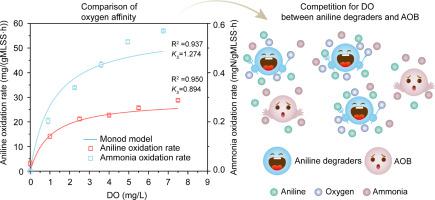Science of the Total Environment ( IF 8.2 ) Pub Date : 2021-01-22 , DOI: 10.1016/j.scitotenv.2021.145205
Yanyan Fan , Xiaolei Chen , Zhangyi Yao , Haisong Li , Dandan Wang , Minhui Tian , Zicong Xu , Junfeng Wan

|
Aniline is a toxic aromatic amine and an inhibitor of nitrification. This study explored the inhibition effect and underlying mechanism. After sludge acclimation, 540 mg/L aniline was removed in 24 h and almost all ammonia released from aniline was oxidized to nitrate. However, nitrification never started until no aniline left. The cellular adenosine triphosphate (cATP) concentration of acclimated sludge reduced only by 2% after aniline exposure. Neither transmembrane transport of ammonia nor ammonia monooxygenase (AMO) activity was affected by aniline. Growing initial aniline concentration did not deteriorate the specific nitrification rate (NR). These all revealed that the toxicity of aniline only play a minor role in inhibition. Competition for dissolved oxygen (DO) was proposed to be another possible inhibition mechanism. The oxygen affinity constant (Ks) of aniline degraders and ammonia-oxidizing bacteria (AOB) was calculated to be 0.894 mg/L and 1.274 mg/L respectively, suggesting the former possessed much stronger oxygen affinity (P < 0.01). With aniline and ammonium as initial substrates, increasing aeration intensity advanced nitrification and increased the NR. Max NR of 0.63 mgN/(gMLSS·h) was achieved at the highest aeration intensity of 1000 mL/min. This study brings one step closer to better removal of aniline and derived nitrogen pollutants.
中文翻译:

苯胺对硝化的新抑制机制:苯胺降解与硝化作用竞争溶解氧
苯胺是有毒的芳香胺和硝化抑制剂。本研究探讨了其抑制作用及其潜在机理。污泥适应后,在24小时内除去540 mg / L苯胺,几乎所有从苯胺释放的氨都被氧化成硝酸盐。但是,直到没有苯胺残留时,硝化作用才开始。苯胺暴露后,适应性污泥的细胞内三磷酸腺苷(cATP)浓度仅降低了2%。氨的跨膜转运和氨单加氧酶(AMO)的活性均不受苯胺的影响。初始苯胺浓度的增加并不会降低比硝化率(NR)。这些都表明苯胺的毒性仅在抑制中起较小作用。有人提出对溶解氧的竞争是另一种可能的抑制机制。苯胺降解物和氨氧化细菌(AOB)的氧亲和常数(Ks)分别为0.894 mg / L和1.274 mg / L,表明前者具有更强的氧亲和力(P <0.01)。以苯胺和铵为初始底物,增加曝气强度可促进硝化作用并增加NR。在1000 mL / min的最高曝气强度下,最大NR为0.63 mgN /(gMLSS·h)。这项研究为更好地去除苯胺和衍生的氮污染物迈出了一步。

































 京公网安备 11010802027423号
京公网安备 11010802027423号